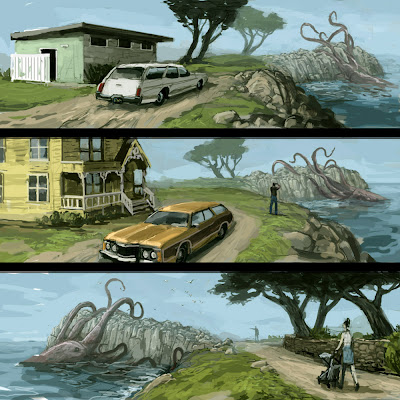*** Create 3 color environment images and print 'em and post 'em. ***
Due on Wednesday, February 19.
On Monday, recent SOU grad Sam Soto, will be in class to show some work and talk shop.
Here's a nifty link he directed me towards...
bit.lyConcept Artist jobs are few. ...and the competition is intense. The competition is so intense, in fact, it gets overwhelming. ...and sometimes even depressing. You're an artist. You're inspired by ...
Wednesday, February 12, 2014
Monday, February 10, 2014
Project 6: Environment Palette Studies
Hair-Raising Hare, Warner Bros, via Animation Backgrounds
1. Dive into Animation Backgrounds and write about the use of limited palette and color design. Show some examples and credit/link to both the blog and the source film.2. Design 10 different color palette schemes of not more than 3-5 colors. Check out Lou Romano's majesty.
Lou Romano, color palette study for Up
3. Pick 5 of your environment thumbnails and do a color palette study for each one using one of your palette designs as a starting point.
We'll look at these on Wednesday, February 12.
Wednesday, February 5, 2014
Project 5: Environment
Post all of this stuff by Monday, February 10:
1. Do 20 thumbnails of environment ideas. See above. Keep it loose and flowing. Don't spend too much time on any one thumbnail. The point is to practice getting an idea down in a pure form without being distracted by detail. Stay loose and discover while you draw. You don't need to know what you're drawing before you draw it. Your approach may end up having similarities to your silhouette work. Thin about foreground, mid-ground, background, areas of interest/focus, dark/light, and scale contrast. You may or may not want to be thinking about what medium you're drawing for (game, movie, animation, film, theater, etc)... or you may not. This is a very primal stage in the creative process, so you don't have to be worried about this... yet... And, yes, print these. Blow 'em up so they're easy to see, if you work small.
2. Go to a location you've never been to before and write about the experience. How did you choose the spot? Why? Describe the sensations, what you noticed, how you felt being there. Describe the place physically, the quality of light, the color, sounds, sights, time of day, etc. What made this place a place? Print this out, so you can share it in class.
3. Collect reference photos for some extended concepts that you can build off of your thumbnails. These references might give you specific details on architecture, lighting, composition, foliage, fauna, urban clutter, tapestries, pastries, patisseries, whatever information you need to flesh out your imaginary world.
Here's where we're going with this stuff eventually...
Preproduction concepts from Fallout 3 by Craig Mullins. A masterly example of collage/painting hybrid approach.
Alex Munn's work is more "painterly" but shows clear use of observed visual reference in the specific car models and architectural styles.
A few of Bill Wray's knockout backgrounds for the 2D animated show, Samurai Jack
Subscribe to:
Posts (Atom)














